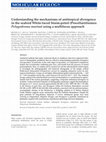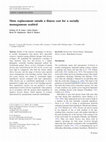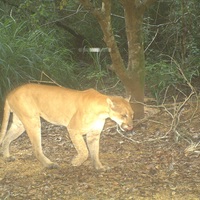Papers by Brent Stephenson

Notornis
We studied the New Zealand morepork (Ninox novaeseelandiae) over 2 breeding seasons on Mokoia I, ... more We studied the New Zealand morepork (Ninox novaeseelandiae) over 2 breeding seasons on Mokoia I, Lake Rotorua, North Island, New Zealand. Ten pairs were monitored in the 1995/96 breeding season and 8 in the 1996/97 season. Nest sites included tree cavities, hollows amongst tree fern fronds, nest boxes provided for saddleback (Philesturnus carunculatus), and scrapes on the ground. Nest cavities were 0-5.2 m agl. Clutch size was 1-3 eggs; egg dimensions averaged 39.0 mm × 32.9 mm. The incubation period for 1 clutch was at least 24 days. Only females were observed to incubate eggs and brood nestlings; males roosted nearby. Two chicks were weighed and measured throughout their development and the nestling period was determined for 1 chick. Nestling development is described. Breeding success was lower in the year after a poisoning operation to eradicate mice from the island. Juvenile mortality was high after fledging. The dispersal of 4 juveniles was monitored, and females appeared to mo...

Molecular Ecology, 2015
Analytical methods that apply coalescent theory to multilocus data have improved inferences of de... more Analytical methods that apply coalescent theory to multilocus data have improved inferences of demographic parameters that are critical to understanding population divergence and speciation. In particular, at the early stages of speciation, it is important to implement models that accommodate conflicting gene trees, and benefit from the presence of shared polymorphisms. Here, we employ eleven nuclear loci and the mitochondrial control region to investigate the phylogeography and historical demography of the pelagic seabird White-faced Storm-petrel (Pelagodroma marina) by sampling subspecies across its antitropical distribution. Groups are all highly differentiated: global mitochondrial Φ ST = 0.89 (P < 0.01) and global nuclear Φ ST varies between 0.22 and 0.83 (all P < 0.01). The complete lineage sorting of the mitochondrial locus between hemispheres is corroborated by approximately half of the nuclear genealogies, suggesting a long-term antitropical divergence in isolation. Coalescent-based estimates of demographic parameters suggest that hemispheric divergence of P. marina occurred approximately 840 000 ya (95% HPD 582 000-1 170 000), in the absence of gene flow, and divergence within the Southern Hemisphere occurred 190 000 ya (95% HPD 96 000-600 000), both probably associated with the profound palaeooceanographic changes of the Pleistocene. A fledgling sampled in St Helena (tropical South Atlantic) suggests recent colonization from the Northern Hemisphere. Despite the great potential for long-distance dispersal, P. marina antitropical groups have been evolving as independent, allopatric lineages, and divergence is probably maintained by philopatry coupled with asynchronous reproductive phenology and local adaptation.
The Wilson Journal of Ornithology, 2014

Naturwissenschaften, 2010
Studies of the selective advantages of divorce in socially monogamous bird species have unravelle... more Studies of the selective advantages of divorce in socially monogamous bird species have unravelled extensive variation among different lineages with diverse ecologies. We quantified the reproductive correlates of mate retention, mate loss and divorce in a highly philopatric, colonially breeding biparental seabird, the Australasian gannet Morus serrator. Estimates of annual divorce rates varied between 40-43% for M. serrator and were high in comparison with both the closely related Morus bassanus and the range of divorce rates reported across monogamous avian breeding systems. Mate retention across seasons was related to consistently higher reproductive success compared with mate replacement, while divorce per se contributed significantly to lower reproductive output only in one of two breeding seasons. Prior reproductive success was not predictive of mate replacement overall or divorce in particular. These patterns are in accordance with the musical chairs hypothesis of adaptive divorce theory, which operates in systems characterised by asynchronous territorial establishment.

Molecular Phylogenetics and Evolution, 2011
In 2003, birds similar to the extinct New Zealand storm-petrel Oceanites maorianus were observed ... more In 2003, birds similar to the extinct New Zealand storm-petrel Oceanites maorianus were observed in Hauraki Gulf NZ, raising the possibility of rediscovery after 150 years. O. maorianus has and continues to be surrounded by taxonomic uncertainty, being variously described as a distinct genus, a distinct species, or merely a plumage variant. This uncertainty has hindered conservation planning and funding for the species. Here we examine the taxonomic identity of the rediscovered birds and museum specimens using phylogenetic analysis of mitochondrial (1143 bp cytochrome b) and nuclear (890 bp β-fibrinogen) genes. Using cytochrome b sequence amplified from the 150+ year old specimens, we found that the extant and museum O. maorianus were the same taxon (0.01 genetic distance), with both differing from all other storm-petrel taxa. Using both genes, we examined the phylogenetic affinities of O. maorianus to the Oceanitinae and Hydrobatinae storm-petrels finding that O. maorianus was more closely aligned to Fregetta (0.08-0.09) than Oceanites (0.11-0.12), thereby confirming its status as a distinct taxon, not a plumage variant of O. oceanicus. Our analysis verifies that the previously presumed extinct New Zealand storm-petrel has been rediscovered and can now be assigned a conservation priority commensurate with its critically endangered status.

Australian Journal of Zoology, 2007
The availability of molecular methods for avian sex identification has revolutionised the study o... more The availability of molecular methods for avian sex identification has revolutionised the study of sexual differences in behaviour, morphology, life-history traits and conservation management. We implemented the recommendations of a recent review of DNA-based sex-identification by (1) verifying the sex-specificity and (2) estimating the accuracy of different sex-assignment methods in an apparently monomorphic seabird, the Australasian gannet (Morus serrator). The polymerase chain reaction (PCR) method based on the amplification of the sex-linked chromodomainhelicase-DNA binding gene (CHD) repeatedly assigned the same sex in 96% (n = 27 replicates) and correctly sexed all individuals with known gonadal anatomy (n = 6). PCR and sex-specific restriction fragment length polymorphism (RFLPs) showed agreement for 99.5% of individuals (n = 201). DNA-sexed pairs known to be social mates consisted of a male and a female in 96% of pairs sexed by PCR (n = 77) and 98% of pairs sexed by RFLP (n = 65). DNA-sexed females were in the bottom and males in the top copulatory position in 86% of observed copulations (n = 43 individuals). These results validate assumptions that both membership in social pairs and different copulatory positions can serve as reliable behavioural proxies for field-based sex identification in this colonial and obligately biparental seabird.

In New Zealand invasive brushtail possums Trichosurus vulpecula reduce nesting success of native ... more In New Zealand invasive brushtail possums Trichosurus vulpecula reduce nesting success of native birds and compete with them for food. As an urban biodiversity initiative, intensive possum control was carried out in a residential area on Napier Hill, North Island. Bird species were monitored using five-minute point counts, conducted once before the possum control programme and then annually for a further five years afterwards. Significant increases in the relative abundance of bellbird Anthornis melanura and tui Prosthemadera novaeseelandiae were attributed to an increase in food supply due to reduced competiton from possums. Kereru Hemiphaga novaeseelandiae numbers remained relatively stable and a significant decline was recorded in the relative abundance of silvereyes Zosterops lateralis. Management of possum populations will be continued to try to further improve native bird abundance on Napier Hill.











Uploads
Papers by Brent Stephenson